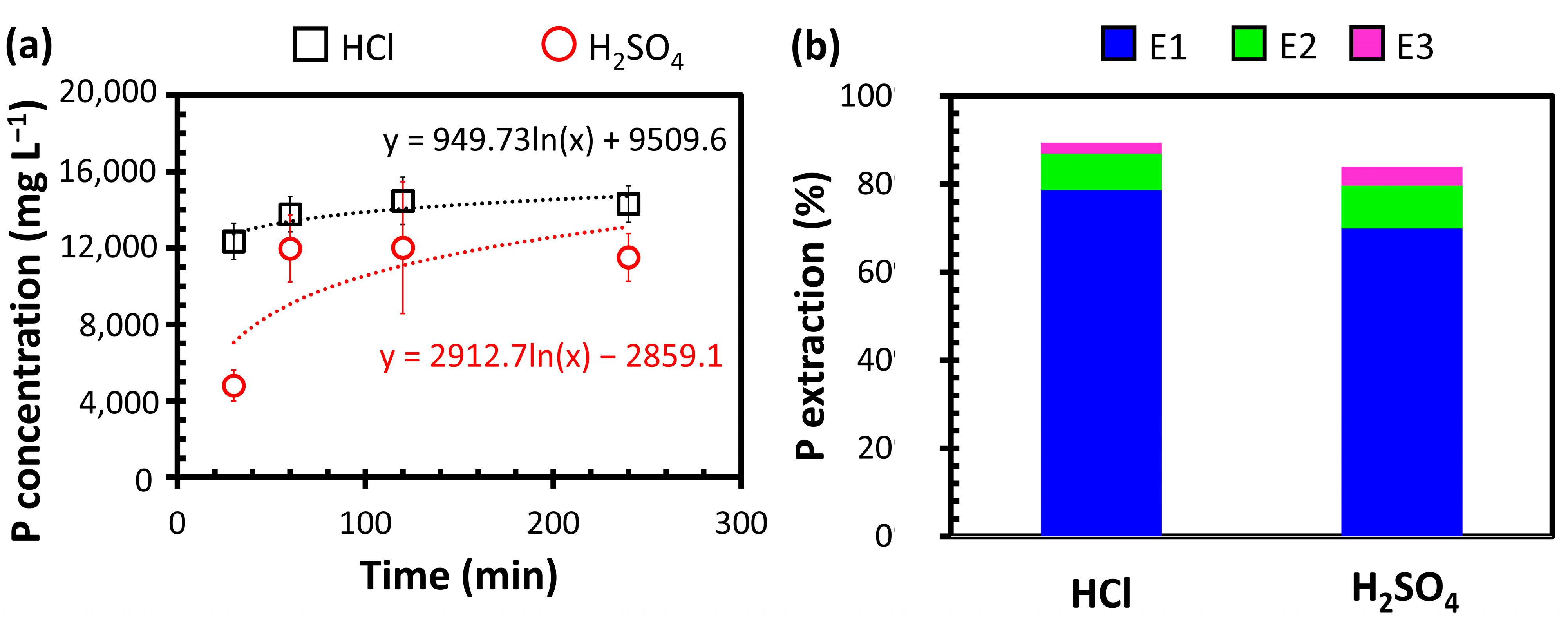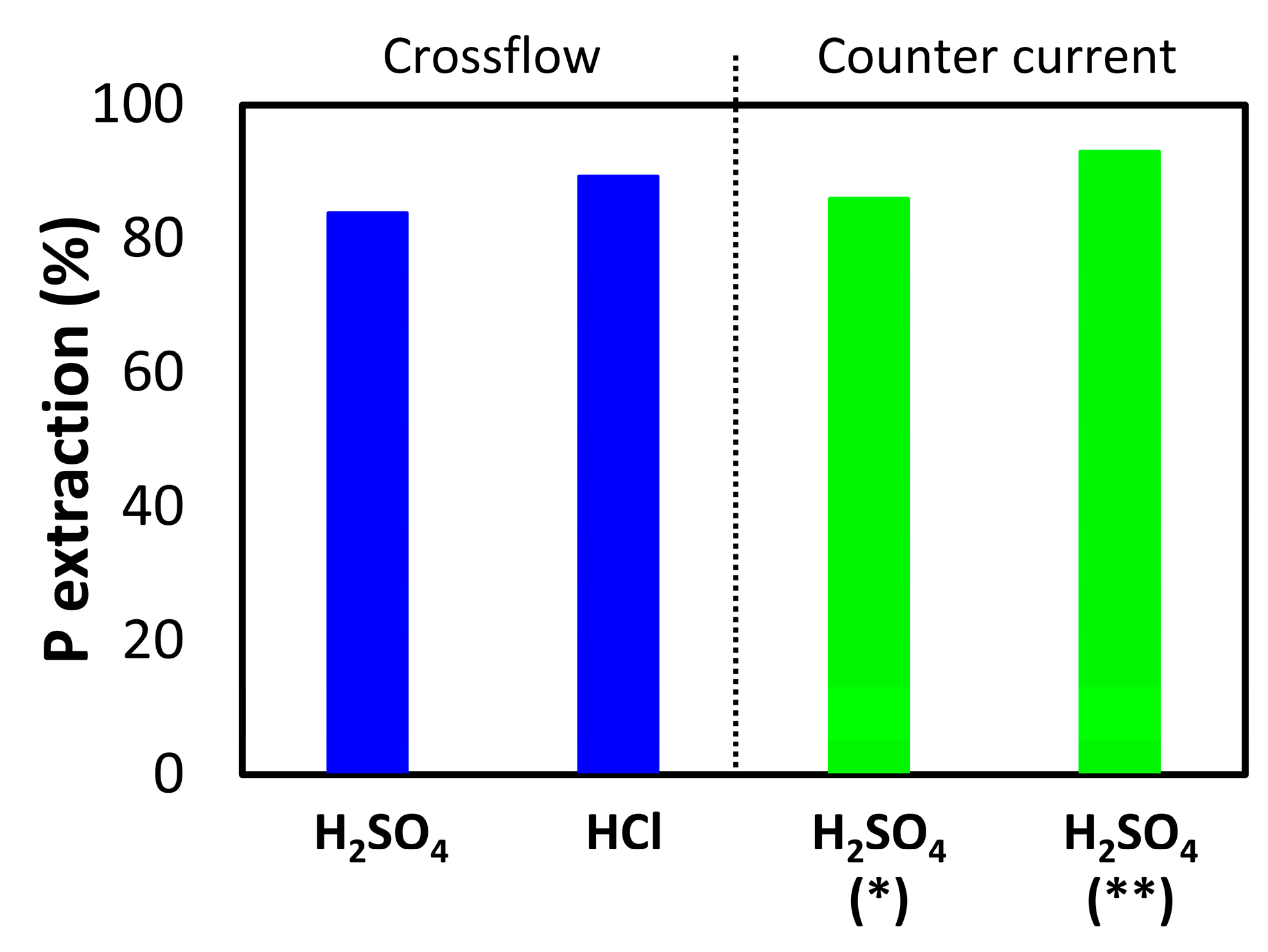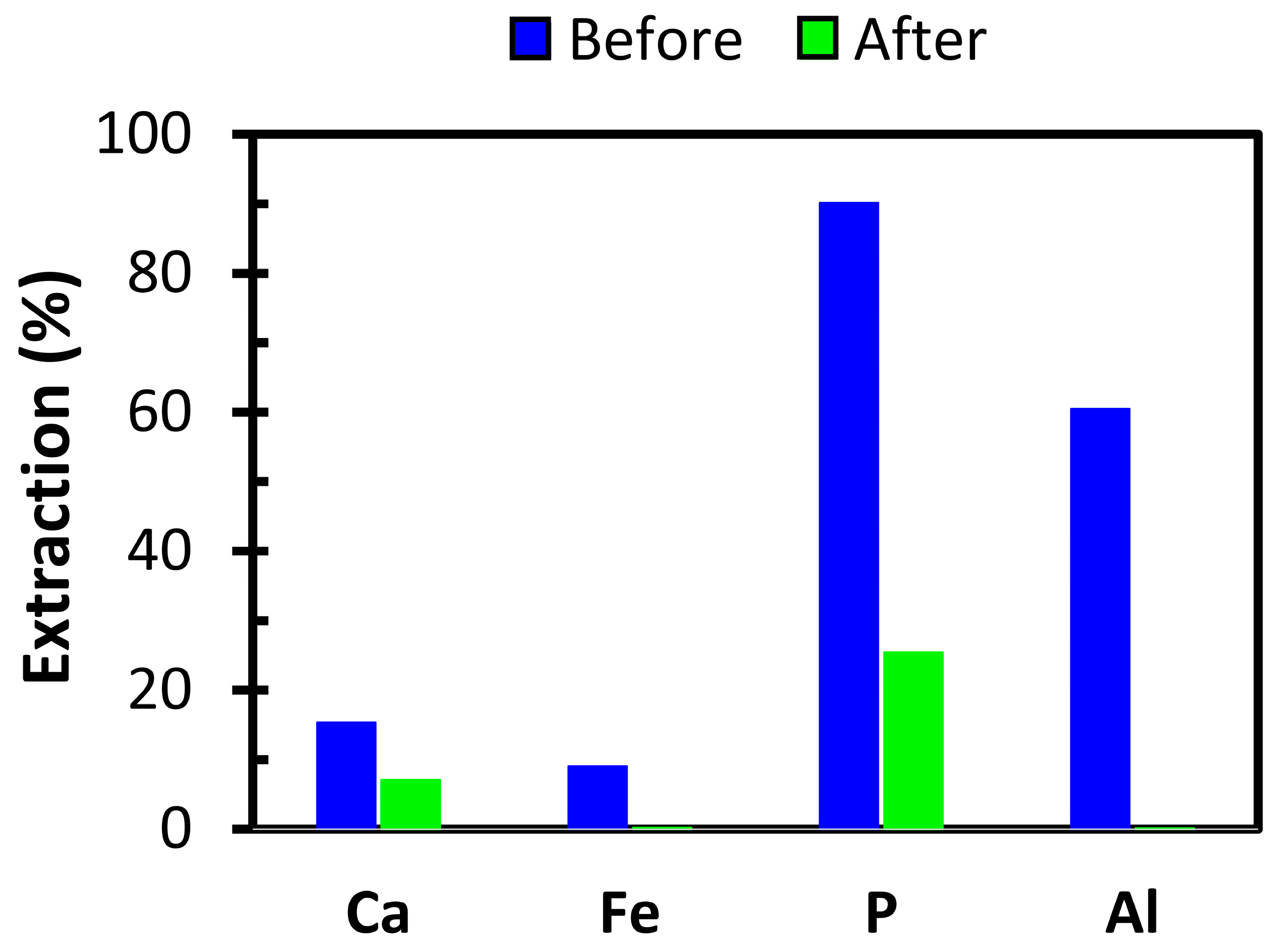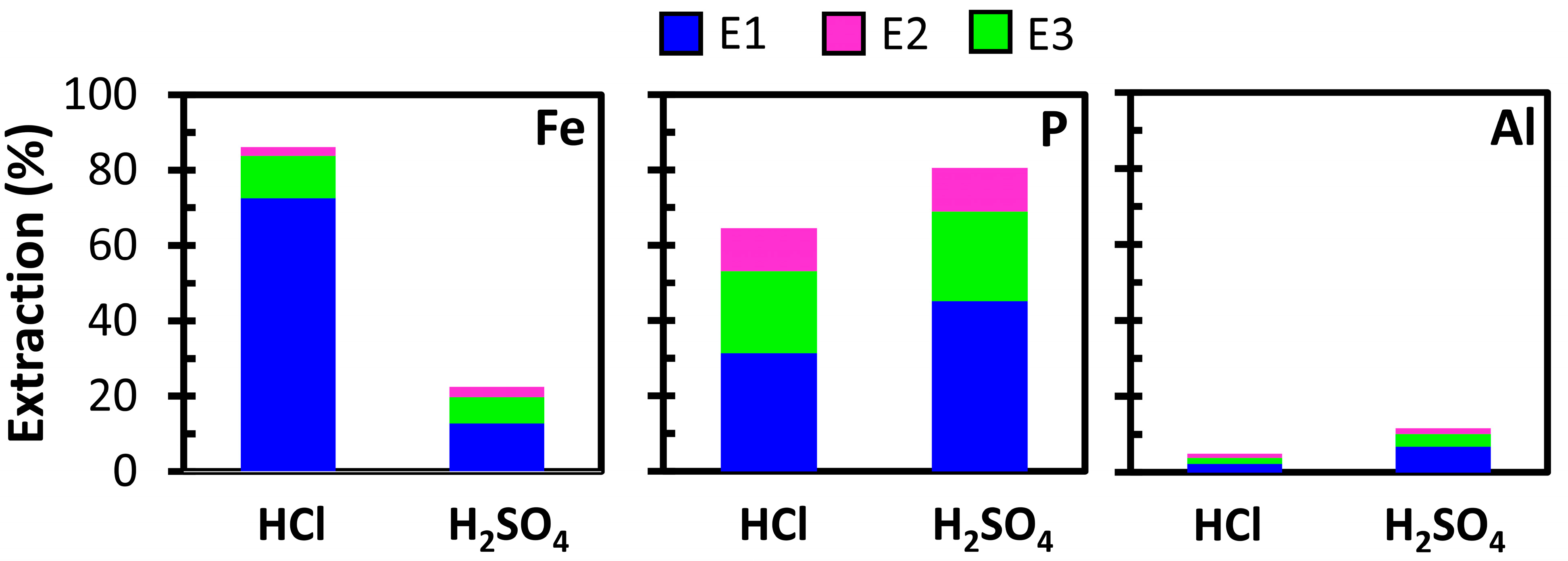Extraction and Purification of Phosphorus from the Ashes of Incinerated Biological Sewage Sludge
Abstract
:1. Introduction
2. Materials and Methods
2.1. Sample Preparation
2.2. Sample Characterization
2.2.1. SEM-EDS
2.2.2. ICP-OES
- m1: 2 mL HNO3 + 7.5 mL HCl + microwave (P = 800 W; T = 175° C; t = 10 min);
- m2: 6 mL HNO3 + 2.5 mL HCl + microwave (P = 800 W; T = 175° C; t = 10 min);
- m3: 7.5 mL HNO3 + 1 mL H2O2 + microwave (P = 800 W; T = 175° C; t = 10 min);
- m4: 2 mL HNO3 + 7.5 mL HCl (boiling temperature; t = 150 min) according to [32];
2.2.3. ED-XRF
2.3. Phosphorus Extraction
2.3.1. Extraction in Crossflow
2.3.2. Extraction in Counter Current
2.4. Phosphorus Purification
2.4.1. Purification by pH Variation
2.4.2. Purification by Organic Solvent Extraction
3. Results and Discussion
3.1. FA and BA Characterization
3.2. Phosphorus Extraction
3.3. Phosphorus Purification
3.3.1. Purification by pH Variation
3.3.2. Purification by Organic Solvent Extraction
4. Conclusions
Supplementary Materials
Author Contributions
Funding
Data Availability Statement
Acknowledgments
Conflicts of Interest
References
- Kominko, H.; Gorazda, K.; Wzorek, Z. The Possibility of Organo-Mineral Fertilizer Production from Sewage Sludge. Waste Biomass Valoriz. 2017, 8, 1781–1791. [Google Scholar] [CrossRef] [Green Version]
- EUR-Lex. Council Directive 91/271/EEC of 21 May 1991 concerning urban waste-water treatment. Off. J. Eur. Communities 1991, 135, 40–52. [Google Scholar]
- EUR-Lex. Commission Directive 98/15/EC of 27 February 1998 amending Council Directive 91/271/EEC with respect to certain requirements established in Annex I thereof. Off. J. Eur. Communities 1998, 67, 29–30. [Google Scholar]
- EUR-Lex. Directive EU/2018/851 of the European Parliament and of the Council of 30 May 2018 Amending Directive 2008/98/EC on Waste. Off. J. Eur. Union 2018, 150, 109–140. [Google Scholar]
- Collivignarelli, M.C.; Abbà, A.; Carnevale Miino, M.; Torretta, V. What Advanced Treatments Can Be Used to Minimize the Production of Sewage Sludge in WWTPs? Appl. Sci. 2019, 9, 2650. [Google Scholar] [CrossRef] [Green Version]
- Bertanza, G.; Papa, M.; Canato, M.; Collivignarelli, M.C.; Pedrazzani, R. How can sludge dewatering devices be assessed? Development of a new DSS and its application to real case studies. J. Environ. Manag. 2014, 137, 86–92. [Google Scholar] [CrossRef]
- Collivignarelli, M.C.; Abbà, A.; Padovani, S.; Frascarolo, M.; Sciunnach, D.; Turconi, M.; Orlando, M. Recovery of sewage sludge on agricultural land in Lombardy: Current issues and regulatory scenarios. Environ. Eng. Manag. J. 2015, 14, 1477–1486. [Google Scholar] [CrossRef]
- Ashekuzzaman, S.M.; Forrestal, P.; Richards, K.; Fenton, O. Dairy industry derived wastewater treatment sludge: Generation, type and characterization of nutrients and metals for agricultural reuse. J. Clean. Prod. 2019. [Google Scholar] [CrossRef]
- Collivignarelli, M.C.; Abbà, A.; Bertanza, G.; Baldi, M.; Setti, M.; Frattarola, A.; Carnevale Miino, M. Treatment of high strength wastewater by thermophilic aerobic membrane reactor and possible valorisation of nutrients and organic carbon in its residues. J. Clean. Prod. 2021, 280. [Google Scholar] [CrossRef]
- Jones, R.J.A.; Hiederer, R.; Rusco, E.; Loveland, P.J.; Montanarella, L. The Map of Organic Carbon in Topsoils in Europe: Explanation of Special Publication Ispra 2004 No.72 (S.P.I.04.72); Joint Research Centre: Luxembourg, 2004. [Google Scholar]
- Napoli, M.; Marta, A.D.; Zanchi, C.A.; Orlandini, S. Assessment of soil and nutrient losses by runoff under different soil management practices in an Italian hilly vineyard. Soil Tillage Res. 2017, 168, 71–80. [Google Scholar] [CrossRef]
- Kanari, N.; Diot, F.; Gauthier, C.; Yvon, J. Use of residual materials for synthesis of lightweight granulates by thermal treatment process. Appl. Clay Sci. 2016, 123, 259–271. [Google Scholar] [CrossRef] [Green Version]
- Collivignarelli, M.C.; Alessandro, A.; Carnevale Miino, M.; Cillari, G.; Ricciardi, P. A review on alternative binders, admixtures and water for the production of sustainable concrete. J. Clean. Prod. 2021, 126408. [Google Scholar] [CrossRef]
- Ukwatta, A.; Mohajerani, A.; Setunge, S.; Eshtiaghi, N. Possible use of biosolids in fired-clay bricks. Constr. Build. Mater. 2015, 91, 86–93. [Google Scholar] [CrossRef]
- Ricciardi, P.; Cillari, G.; Carnevale Miino, M.; Collivignarelli, M.C. Valorization of agro-industry residues in building and environmental sector: A review. Waste Manag. Res. 2020, 1–26. [Google Scholar] [CrossRef]
- Singh, V.; Phuleria, H.C.; Chandel, M.K. Estimation of energy recovery potential of sewage sludge in India: Waste to watt approach. J. Clean. Prod. 2020, 276, 122538. [Google Scholar] [CrossRef]
- Das, P.; Khan, S.; AbdulQuadir, M.; Thaher, M.; Waqas, M.; Easa, A.; Attia, E.S.M.; Al-Jabri, H. Energy recovery and nutrients recycling from municipal sewage sludge. Sci. Total Environ. 2020, 715, 136775. [Google Scholar] [CrossRef]
- Zhang, H.; Gong, M.; Ding, L.; Su, Y. Energy recovery and phosphorus phase behaviour from catalytic gasification of cyanobacterial biomass in supercritical water. Biomass Bioenergy 2020, 134, 105477. [Google Scholar] [CrossRef]
- Liu, Z.; Mayer, B.K.; Venkiteshwaran, K.; Seyedi, S.; Raju, A.S.K.; Zitomer, D.; McNamara, P.J. The state of technologies and research for energy recovery from municipal wastewater sludge and biosolids. Curr. Opin. Environ. Sci. Health 2020, 14, 31–36. [Google Scholar] [CrossRef]
- Huber, F. Modelling of material recovery from waste incineration bottom ash. Waste Manag. 2020, 105, 61–72. [Google Scholar] [CrossRef] [PubMed]
- Nihalani, S.A.; Mishra, Y.D.; Meeruty, A.R. Handling and Utilisation of Fly Ash from Thermal Power Plants. In Circular Economy and Fly Ash Management; Springer: Singapore, 2020; pp. 1–11. [Google Scholar]
- Falk, J.; Skoglund, N.; Grimm, A.; Öhman, M. Fate of Phosphorus in Fixed Bed Combustion of Biomass and Sewage Sludge. Energy Fuels 2020, 34, 4587–4594. [Google Scholar] [CrossRef] [Green Version]
- Nordin, A.; Strandberg, A.; Elbashir, S.; Åmand, L.-E.; Skoglund, N.; Pettersson, A. Co-Combustion of Municipal Sewage Sludge and Biomass in a Grate Fired Boiler for Phosphorus Recovery in Bottom Ash. Energies 2020, 13, 1708. [Google Scholar] [CrossRef] [Green Version]
- Karamesouti, M.; Gasparatos, D. Sustainable Management of Soil Phosphorus in a Changing World. In Adaptive Soil Management: From Theory to Practices; Springer: Singapore, 2017; pp. 189–214. [Google Scholar]
- Helin, J.; Weikard, H.-P. A model for estimating phosphorus requirements of world food production. Agric. Syst. 2019, 176, 102666. [Google Scholar] [CrossRef]
- Alewell, C.; Ringeval, B.; Ballabio, C.; Robinson, D.A.; Panagos, P.; Borrelli, P. Global phosphorus shortage will be aggravated by soil erosion. Nat. Commun. 2020, 11, 4546. [Google Scholar] [CrossRef]
- Van Vuuren, D.P.; Bouwman, A.F.; Beusen, A.H.W. Phosphorus demand for the 1970–2100 period: A scenario analysis of resource depletion. Glob. Environ. Chang. 2010, 20, 428–439. [Google Scholar] [CrossRef]
- Wollmann, I.; Gauro, A.; Müller, T.; Möller, K. Phosphorus bioavailability of sewage sludge-based recycled fertilizers. J. Plant. Nutr. Soil Sci. 2018, 181, 158–166. [Google Scholar] [CrossRef]
- Franz, M. Phosphate fertilizer from sewage sludge ash (SSA). Waste Manag. 2008, 28, 1809–1818. [Google Scholar] [CrossRef]
- Ottosen, L.M.; Kirkelund, G.M.; Jensen, P.E. Extracting phosphorous from incinerated sewage sludge ash rich in iron or aluminum. Chemosphere 2013, 91, 963–969. [Google Scholar] [CrossRef]
- Ashley, K. International Conference on Nutrient Recovery from Wastewater Streams (Vancouver, 2009). Water Intell. Online 2009, 8. [Google Scholar] [CrossRef]
- Fang, L.; Wang, Q.; Li, J.; Poon, C.S.; Cheeseman, C.R.; Donatello, S.; Tsang, D.C.W. Feasibility of wet-extraction of phosphorus from incinerated sewage sludge ash (ISSA) for phosphate fertilizer production: A critical review. Crit. Rev. Environ. Sci. Technol. 2020, 1–33. [Google Scholar] [CrossRef]
- Fang, L.; Li, J.; Donatello, S.; Cheeseman, C.R.; Wang, Q.; Poon, C.S.; Tsang, D.C.W. Recovery of phosphorus from incinerated sewage sludge ash by combined two-step extraction and selective precipitation. Chem. Eng. J. 2018, 348, 74–83. [Google Scholar] [CrossRef]
- Fang, L.; Li, J.; Guo, M.Z.; Cheeseman, C.R.; Tsang, D.C.W.; Donatello, S.; Poon, C.S. Phosphorus recovery and leaching of trace elements from incinerated sewage sludge ash (ISSA). Chemosphere 2018, 193, 278–287. [Google Scholar] [CrossRef] [PubMed]
- Xu, H.; He, P.; Gu, W.; Wang, G.; Shao, L. Recovery of phosphorus as struvite from sewage sludge ash. J. Environ. Sci. 2012, 24, 1533–1538. [Google Scholar] [CrossRef]
- Shlewit, H. Treatment of phosphate rocks with hydrochloric acid. J. Radioanal. Nucl. Chem. 2011, 287, 49–54. [Google Scholar] [CrossRef]
- Awwad, N.S.; El-Nadi, Y.A.; Hamed, M.M. Successive processes for purification and extraction of phosphoric acid produced by wet process. Chem. Eng. Process. Process. Intensif. 2013, 74, 69–74. [Google Scholar] [CrossRef]
- U.S. EPA. Method 200.7: Determination of Metals and Trace Elements in Water and Wastes by Inductively Coupled Plasma-Atomic Emission Spectrometry; United States Environmental Protection Agency: Cincinnati, OH, USA, 1994.
- Baniel, A.; Blumberg, R. Process for the Preparation of the Phosphoric Acid. U.S. Patent No. 2880063, 31 March 1959. [Google Scholar]
- Baniel, A.; Blumberg, R.; Alon, A.; El Roy, M.; Goniadski, D. The IMI phosphoric acid process. Chem. Eng. Prog. 1962, 58, 100–104. [Google Scholar]
- Giua, M. Treatise on Industrial Chemistry; USES Edizioni Scientifiche: Firenze, Italy, 1972. (In Italian) [Google Scholar]
- Al-Fariss, T.F.; Özbelge, H.Ö.; El-Shall, H.S.H. Process Technology for Phosphoric Acid Production in Saudi Arabia. J. King Saud Univ. Eng. Sci. 1992, 4, 239–254. [Google Scholar] [CrossRef]
- Ukeles, S.D.; Raz, I.; Friedman, G.; Kogan, L. Effluent treatment in IMI Phosphoric Acid Process. In Hydrometallurgy ’94; Springer: Dordrecht, The Netherlands, 1994; pp. 1059–1071. [Google Scholar]
- Prabhakar, A.K.; Cadiam Mohan, B.; Tay, T.S.; Lee, S.S.-C.; Teo, S.L.-M.; Wang, C.-H. Incinerated Sewage Sludge Bottom Ash- Chemical processing, Leaching patterns and Toxicity testing. J. Hazard. Mater. 2021, 402, 123350. [Google Scholar] [CrossRef]
- Kleemann, R.; Chenoweth, J.; Clift, R.; Morse, S.; Pearce, P.; Saroj, D. Comparison of phosphorus recovery from incinerated sewage sludge ash (ISSA) and pyrolysed sewage sludge char (PSSC). Waste Manag. 2017, 60, 201–210. [Google Scholar] [CrossRef] [Green Version]
- Donatello, S.; Tong, D.; Cheeseman, C.R. Production of technical grade phosphoric acid from incinerator sewage sludge ash (ISSA). Waste Manag. 2010, 30, 1634–1642. [Google Scholar] [CrossRef] [Green Version]
- Onuigbo, E.N.; Okoro, A.U.; Okolo, C.M.; Chibuzor, S.N. Elemental Composition of the Phosphorites of the AmekiFormation around Bende-Ameke Area, Southeastern Nigeria: Potential for Environmental Pollution. Int. Res. J. Appl. Sci. 2020, 2, 28–33. [Google Scholar]
- Bouabdallah, M.; Elgharbi, S.; Horchani-Naifer, K.; Barca, D.; Fattah, N.; Férid, M. Chemical, mineralogical and rare earth elements distribution study of phosphorites from Sra Ouertane deposit (Tunisia). J. Afr. Earth Sci. 2019, 157, 103505. [Google Scholar] [CrossRef]
- Pochitalkina, I.A.; Kondakov, D.F.; Artamonova, O.A.; Vinokurova, O.V. Textural and structural characteristics of phosphorites from the Polpinsky deposit. Russ. J. Inorg. Chem. 2017, 62, 1495–1498. [Google Scholar] [CrossRef]
- Kaljuvee, T.; Tõnsuaadu, K.; Traksmaa, R.; Einard, M.; Jefimova, J.; Petkova, V. Thermal behaviour of Estonian phosphorites from different deposits. J. Therm. Anal. Calorim. 2020, 142, 437–449. [Google Scholar] [CrossRef]
- Benassi, L.; Zanoletti, A.; Depero, L.E.; Bontempi, E. Sewage sludge ash recovery as valuable raw material for chemical stabilization of leachable heavy metals. J. Environ. Manag. 2019, 245, 464–470. [Google Scholar] [CrossRef] [PubMed]
- Biswas, B.K.; Inoue, K.; Harada, H.; Ohto, K.; Kawakita, H. Leaching of phosphorus from incinerated sewage sludge ash by means of acid extraction followed by adsorption on orange waste gel. J. Environ. Sci. 2009, 21, 1753–1760. [Google Scholar] [CrossRef]
- Wang, Q.; Li, J.; Tang, P.; Fang, L.; Poon, C.S. Sustainable reclamation of phosphorus from incinerated sewage sludge ash as value-added struvite by chemical extraction, purification and crystallization. J. Clean. Prod. 2018, 181, 717–725. [Google Scholar] [CrossRef]
- Hong, K.-J.; Tarutani, N.; Shinya, Y.; Kajiuchi, T. Study on the Recovery of Phosphorus from Waste-Activated Sludge Incinerator Ash. J. Environ. Sci. Health 2005, 40, 617–631. [Google Scholar] [CrossRef]
- He, P.; Zhang, X.; Lü, F.; Shao, L.; Zhang, H. Leaching behavior of phosphorous compounds from sewage sludge ash based on quantitative X-ray diffraction analysis. Waste Dispos. Sustain. Energy 2020, 2, 113–125. [Google Scholar] [CrossRef] [Green Version]
- Goldshmid, T.; Rubin, A.J. Determination of Soluble Species and Precipitates of Aluminum Phosphate. Sep. Sci. Technol. 1988, 23, 2269–2291. [Google Scholar] [CrossRef]





| Bottom ash (BA) | Fly ash (FA) | |||||||
|---|---|---|---|---|---|---|---|---|
| SEM-EDS | IPC-OES | ED-XRF | SEM-EDS | ED-XRF | ||||
| m1 | m2 | m3 | m4 | |||||
| Mg (%) | 1.7 | 1.4 | 1.5 | 1.3 | 1.4 | 1.8 | 1.8 | 2.1 |
| Al (%) | 4.1 | 2.2 | 2.1 | 1.9 | 2.1 | 4.7 | 3.9 | 5.2 |
| Si (%) | 14.5 | n.a. | n.a. | n.a. | n.a. | 18 | 12.9 | 15 |
| P (%) | 6.8 | 4.5 | 5.1 | 5 | 5.1 | 6.4 | 6.88 | 7.4 |
| S (%) | n.a. | n.a. | n.a. | n.a. | n.a. | n.a. | 0.35 | n.a. |
| K (%) | 1.53 | 0.71 | 0.58 | 0.57 | 0.62 | 1.8 | 1.36 | 1.6 |
| Ca (%) | 7 | 5.7 | 5.8 | 5.6 | 5.7 | 5.8 | 7.7 | 7.2 |
| Ti (%) | 0.66 | n.a. | n.a. | n.a. | n.a. | n.a. | 0.66 | n.a. |
| Fe (%) | 15.4 | 9.4 | 11 | 7 | 11 | 11 | 17.5 | 15 |
| Cu (%) | n.a. | n.a. | n.a. | n.a. | n.a. | n.a. | 0.29 | n.a. |
| Crossflow Extraction | Counter Current Extraction | |||
|---|---|---|---|---|
| H2SO4 | HCl | H2SO4 (1:5) | H2SO4 (1:10) | |
| Al (%) | 0.99 | 1.20 | 1.20 | 1.50 |
| Ca (%) | 0.06 | 5.10 | 0.32 | 0.65 |
| Fe (%) | 1.30 | 0.90 | 0.89 | 0.89 |
| K (%) | 0.16 | 0.28 | 0.34 | 0.27 |
| Mg (%) | 0.95 | 1.10 | 1.20 | 1.30 |
| P (%) | 4.20 | 4.40 | 4.40 | 4.70 |
Publisher’s Note: MDPI stays neutral with regard to jurisdictional claims in published maps and institutional affiliations. |
© 2021 by the authors. Licensee MDPI, Basel, Switzerland. This article is an open access article distributed under the terms and conditions of the Creative Commons Attribution (CC BY) license (https://creativecommons.org/licenses/by/4.0/).
Share and Cite
Baldi, M.; Martinotti, A.; Sorlini, S.; Katsoyiannis, I.A.; Abbà, A.; Carnevale Miino, M.; Collivignarelli, M.C. Extraction and Purification of Phosphorus from the Ashes of Incinerated Biological Sewage Sludge. Water 2021, 13, 1102. https://doi.org/10.3390/w13081102
Baldi M, Martinotti A, Sorlini S, Katsoyiannis IA, Abbà A, Carnevale Miino M, Collivignarelli MC. Extraction and Purification of Phosphorus from the Ashes of Incinerated Biological Sewage Sludge. Water. 2021; 13(8):1102. https://doi.org/10.3390/w13081102
Chicago/Turabian StyleBaldi, Marco, Andrea Martinotti, Sabrina Sorlini, Ioannis A. Katsoyiannis, Alessandro Abbà, Marco Carnevale Miino, and Maria Cristina Collivignarelli. 2021. "Extraction and Purification of Phosphorus from the Ashes of Incinerated Biological Sewage Sludge" Water 13, no. 8: 1102. https://doi.org/10.3390/w13081102








